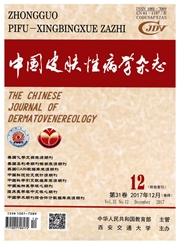

 中文摘要:
中文摘要:
目的 探讨CCR6(human chemokine receptor 6)基因多态性与蒙古族人群白癜风的遗传关联性。方法 收集散发型蒙古族白癜风患者425例,正常对照503例,选择位于CCR6基因区域的2个单核苷酸多态性(SNP)位点(rs2236313和rs6902119),利用连接酶检测反应进行基因分型。结果 rs2236313的等位基因T在病例组的频率明显高于在对照组中的频率(P=2.24×10-3,OR=1.33)。而rs6902119的等位基因C在病例组中的频率明显高于在对照组中的频率(P=5.57×10-5,OR=1.47)。2个SNP间存在强连锁不平衡(D'=0.892,r2=0.74)。基因型分析结果显示,rs2236313在隐性遗传模式下,基因型分布在病例组中的频率显著低于对照组(P〈0.01)。而rs6902119在显性遗传及隐性遗传模式下,基因型分布在病例组中的频率均显著高于对照组(P〈0.01),但在隐性遗传模式下,P值更为显著,OR值更大。结论 CCR6基因多态性可能与蒙古族人群白癜风有相关性。
 英文摘要:
英文摘要:
Objective To investigate the association of Human chemokine receptor 6(CCR6 )and vitiligo in Chinese Mongolian. Methods Four hundred and twenty-five Vitiligo patients and 503 controls were collected. Two single nucleotide polymorphisms(SNP)in CCR6 were selected for genotyping,which included rs2236313 and rs6902119. Genotyping was performed by the ligation detection reaction(LDR).Results Allele frequencies of rs2236313-T in cases was significantly higher than controls(P=2.24×10-3,OR=1.33),but Allele frequencies of rs6902119-C in cases was significantly lower than control(P=5.57×10-5,OR=1.47). Two SNPs were in strong linkage disequilibrium(LD)with each other(D'=0.892,r2=0.74). The genotype of rs2236313 in cases showed significantly lower than controls in the recessive model(P〈0.01),and the genotype of rs6902119 in cases showed significantly higher than controls in both the recessive model and the dominant model(P〈0.01),especially in the recessive model.Conclusion CCR6 might be a susceptible gene for vitiligo in Chinese Mongolian.
 同期刊论文项目
同期刊论文项目
 同项目期刊论文
同项目期刊论文
 期刊信息
期刊信息
